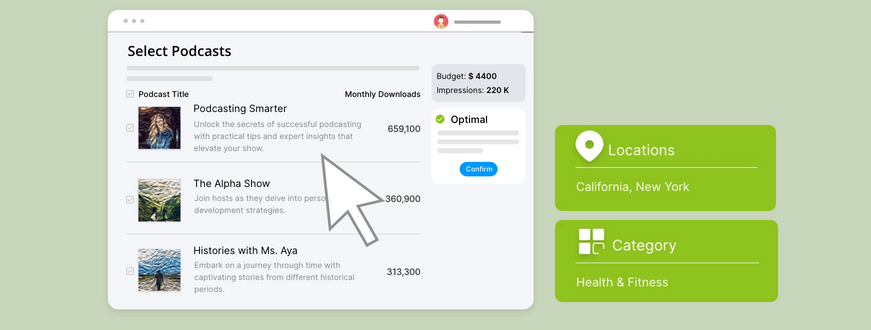The Ultimate Guide to Podcast Advertising
From Understanding the Basics to Launching Successful Campaigns: Everything You Need to Know About Podcast Advertising

Welcome to the exciting world of podcast advertising!
Whether you're from a large company, a small business, an agency, or a podcaster yourself, you likely already appreciate the unique power and influence of podcasts. Now, you're ready to explore opportunities in this dynamic field.
Podbean, with over 148,000 active podcasts, is not only a leading podcast hosting platform but also offers the Podbean Ads Marketplace—a professional platform that connects advertisers with podcasters and has helped hundreds achieve their goals.
In this ultimate guide, we'll take you through the essentials of podcast advertising, from understanding its fundamentals to mastering effective strategies.
What is Podcast Advertising?

Podcast advertising is a dynamic and engaging way to connect with audiences, delivered right through their earbuds. At its core, it includes audio ads that seamlessly blend into podcast episodes.
These ads can take on various forms, from a brief and punchy traditional advertisement to a longer, more conversational endorsement by the podcast host. What's more, these ads can strategically appear at different points in an episode—whether it's at the beginning (pre-roll), in the middle (mid-roll), or at the end (post-roll)—ensuring they capture the listener's attention at just the right moment.
Why Choose Podcast Advertising?
In 2024, podcasting continues to surge in popularity, with a remarkable 546.7 million listeners globally. In the United States alone, the podcast audience has been expanding steadily, hitting around 135 million listeners. Nearly half of the U.S. population aged 12+ now tunes in to a podcast at least once a month.
Reflecting this booming interest, global podcast ad spending is projected to reach an astounding $4.02 billion. (Source: Backlinko) So, why invest in podcast advertising? Because it delivers results. Let’s explore its effectiveness and uncover the benefits.

Go Beyond Traditional Media
Podcasts have emerged as a powerful medium to connect with audiences that traditional channels often miss. They uniquely reach new consumers, particularly among younger demographics who are shifting away from AM/FM radio and TV. By integrating podcast advertising into media strategies, brands can capture up to an additional 15% of 25-to-54-year-olds who are not reachable through TV, and 12% through radio. (Source: Sounds Profitable)
Also, as stress from social media drives Gen Z and millennials to seek solace and inspiration elsewhere, podcasts are becoming their go-to for relaxation and personal growth. With podcast ads, you extend your reach beyond traditional media and social platforms, engaging a diverse and attentive audience.
Reach Highly Targeted Audiences
Podcasts excel at connecting with highly targeted audiences by tapping into niche interests and communities. Unlike traditional broad-spectrum advertising, which often spreads a message too thin, podcasts allow advertisers to focus on specific listener groups.
Research in attention science shows that we're more likely to engage with content that speaks to our personal interests and identities. By partnering with podcasts that align with these aspects, advertisers can capture an audience that is naturally more attentive and receptive, ensuring their messages truly resonate.
Captivate Attention with Deep Engagement
Podcasts have a unique ability to capture and hold listeners' attention through compelling storytelling. Their natural narrative style activates areas of the brain involved in processing complex information, making the content—and any embedded ads—more engaging and memorable.
The unparalleled level of engagement is highlighted by the fact that 81% of podcast listeners report paying attention to ads—far surpassing the 63% who often ignore TV commercials—and delivering 2~3 times the engagement of traditional radio advertising due to the tailored and immersive nature of podcast content. This makes podcast ads both effective and impactful. (Source: PayTunes)
Drive Action Through Authentic Connection
Podcasts not only capture attention but also inspire listeners to take action. Studies show that consumers prefer hearing about products on podcasts more than any other channel, with 68% more likely to consider a product after learning about it through a podcast. This surpasses other platforms like YouTube, social media, and TV. (Source: Ad Results Media)
Host-read ads are particularly effective, as they harness the trust and connection built between listeners and their favorite hosts. A recent listener study found that 90% of podcast listeners took action after hearing an ad, 78% researched the product, and 57% made a purchase. This is because podcasts foster intimate communities where listeners feel connected to the hosts, making their endorsements highly persuasive. (Source: SiriusXM Media)
Who Can Benefit from Podcast Advertising?

Podcast advertising is a versatile tool that can benefit businesses and brands of all types, catering to a wide array of promotional needs. Whether you aim to build brand awareness, drive sales, or reach niche markets, podcast ads offer a flexible solution tailored to your specific goals. With various strategies available, you can craft campaigns to achieve distinct outcomes. (We’ll explore these strategies in the following section, How Does Podcast Advertising Work?)
Brands & Businesses
Podcast advertising offers brands of all sizes an extraordinary opportunity to connect with highly attentive and engaged audiences.
For large enterprises aiming for extensive brand awareness, podcast advertising is an ideal channel to reach millions of listeners, whether launching a new product or promoting seasonal sales. Brands seeking growth and distinction can deeply collaborate with carefully selected, well-matched podcasts to effectively engage potential audiences and enhance their brand image.
For startups, podcast advertising presents a unique opportunity to reach niche audiences through storytelling and highlighting the uniqueness. By leveraging self-serve advertising platforms like Spotify, Acast, Podbean, etc., campaigns can begin with rather low budgets. These platforms allow startups to precisely target audiences that align with their brand, ensuring maximum effectiveness and a strong return on investment.
Podcasters
If you are a podcaster, integrating podcast advertising into your promotional strategy can significantly accelerate your growth. Advertising on podcasts remains the most effective way to introduce your show to potential listeners. By focusing on shows with similar interests, you can connect with audiences who are naturally inclined to engage with your content, effectively expanding your listener base and reaching your ideal audience.
Content creators & Influencers
For content creators and influencers, podcast advertising provides an exceptional opportunity to connect with niche audiences through the genuine and personal medium of audio. This approach allows for authentic self-expression and fosters a deeper bond with listeners who are passionate about similar themes. By targeting podcasts that align with your niche, you can reach people who are more likely to appreciate your work, follow you on social media, and engage with your content.
How Does Podcast Advertising Work?
In this section, we will explore the ins and outs of podcast advertising by examining different ad types, insertion methods, and placement options. These are key factors to consider when developing an effective advertising strategy. We'll provide a detailed look at each type, identify who they are best suited for, and discuss the expected outcomes. Whether you’re seeking broad reach or aiming to connect with niche audiences, understanding these elements will enhance the effectiveness of your podcast advertising approach.
Podcast Ad Types
There are three main advertising formats in podcast advertising: pre-recorded ads, host-read sponsorships, and branded content.

Pre-recorded Ads
Pre-recorded ads (also known as announcer-read or pre-produced ads), are ready-made commercial messages. These ads typically feature a professional voice-over artist and are well-produced. (Some platforms, like Podbean, now offer AI tools to quickly craft the audio ads.) Usually lasting between 15 to 30 seconds, pre-recorded ads are designed to highlight key points and capture listeners' interest swiftly.
Host-read Sponsorships
Host-read sponsorships are personalized endorsements delivered directly by the podcast hosts themselves, often sharing personal experiences and reasons for recommending a product, service, or content. These ads usually last from one to several minutes, enabling an authentic and detailed narrative. The strength of host-read sponsorships lies in their power to engage listeners and establish trust. By naturally fitting into the flow of the podcast, the host's personal touch makes these messages feel genuine and trustworthy, increasing the audience's likelihood to engage with the promoted products or services.
Branded Content
Branded content takes podcast advertising to a deeper level by integrating promotional messages into the fabric of the podcast's editorial content. This approach can involve an entire episode, a series, or even the whole podcast, featuring interviews, discussions, and curated content that goes beyond simple promotion. Rather than just pitching a product, branded content tells a brand's story, builds its identity, and forges a stronger connection with listeners.
| Ad Types | Pre-recorded Ads | Host-read Sponsorships | Branded Content |
|---|---|---|---|
| Content Delivery | Professionally read and produced | Delivered by podcast hosts | Integrated into the podcast's editorial content |
| Duration | Shorter, typically 15-30 seconds | Longer, ranging from 1 to several minutes | Can span an entire episode, series, or whole podcast |
| Style | Polished and concise | More personal and engaging | In-depth storytelling and curated content |
| Best for | Quick, targeted reach | Trust-building and listener engagement | Building brand identity and creating deep connections |
Ad Insertion Methods
Next, how are ads placed within podcast episodes? There are two main methods: Baked-in ads and Dynamic Ad Insertion (DAI).
Baked-in Ads
Baked-in ads are permanently embedded into the podcast's audio file, allowing all listeners to hear the same ad no matter when they listen. These ads remain as part of the podcast for as long as it is available.
Dynamic Ad Insertion (DAI)

Compared to baked-in ads, dynamic ad insertion (DAI) offers greater flexibility and efficiency. It is a process where ads are automatically inserted into podcast episodes in real-time, keeping ads fresh and relevant, even in older episodes.
With DAI, advertisers can precisely target specific audiences, choose when their campaign runs, select where ads appear in an episode, and control how often listeners hear them, among other options. This method allows for custom budgets and settings that can be adjusted as needed to meet campaign goals.
DAI is now widely used across most advertising platforms, including Podbean, Buzzsprout, Acast, etc., making it the preferred choice for pre-recorded and many host-read ads. This dynamic approach maximizes both reach and impact.
Ad Placements
The timing of your ad can also impact its effectiveness. These timings, known as ad placements or ad time slots, determine when listeners will hear your ad during a podcast episode. There are three main types: pre-roll, mid-roll, and post-roll. Each placement offers unique advantages and reaches listeners in different states of engagement, making it an essential aspect to consider when crafting your advertising strategy.

Pre-Roll Ads
Pre-roll ads play at the start or within the first few minutes of a podcast episode, typically lasting 15 to 30 seconds. These ads catch listeners when they're most attentive, making them great for building brand awareness.
Mid-Roll Ads
Mid-roll ads are placed in the middle section of episodes, typically after the first 10 minutes. These ads can range from 30 seconds to several minutes. They are highly effective as listeners are usually engaged and less likely to skip, making them ideal for impactful messages and calls to action.
Post-Roll Ads
Post-roll ads appear at the end or near the end of episodes, lasting 15 to 30 seconds. While some listeners may tune out before they play, these ads can still be effective for reinforcing messages.
| Ad Placements | Pre-Roll | Mid-Roll | Post-Roll |
|---|---|---|---|
| Position in Episode | Start or within the first 5 minutes | Middle section, typically after 10 minutes | End or near the end |
| Typical Duration | 15 to 30 seconds | 30 seconds to several minutes | 15 to 30 seconds |
| Advantages | Captures early attention, ideal for brand awareness | High engagement, suitable for detailed messages and calls to action | Reinforces messages |
Choosing the right ad placement or combination depends on your goals and ad message. Platforms like Podbean offer flexibility, allowing you to select placements that align with your campaign strategy.
How Much Does Podcast Advertising Cost?
Determining the cost of podcast advertising can vary widely, with factors such as ad type, insertion method, and placement (pre-roll, mid-roll, or post-roll) all playing a role. The most commonly used pricing model is CPM, which stands for cost per 1,000 impressions. Simply put, it's the amount you pay for your ad to be heard 1,000 times.

For your reference, here are the current CPM ranges: Pre-recorded ads generally range from $15 to $25 CPM, while host-read ad campaigns typically have a CPM between $15 and $30. Regarding ad placement, mid-roll ads usually have the highest CPM, followed by pre-roll, and then post-roll.
Where to Buy Podcast Advertising?
Now that you have a solid understanding of podcast advertising, the next question is: where can you actually launch your ads? Let's explore the main channels.
Reach Out to Podcasters or Networks
If you have specific podcasts or networks in mind, reaching out to them directly can be an approach. This method is ideal for brands looking for a personalized touch, allowing for pre-recorded ads as well as deeper integrations like host-read ads and branded content. Direct collaboration provides flexibility in creating unique ad experiences that resonate with the podcast's audience.
Through Demand-Side Platforms (DSP)
For advertisers seeking scalable campaigns with substantial budgets, Demand-Side Platforms (DSPs) offer a powerful solution. DSPs connect advertisers with a broad array of podcasts, enabling automated and data-driven ad distribution. This approach is particularly suitable for large-scale or long-term pre-recorded ad campaigns, which often require larger budgets but benefit from more favorable CPM rates. Examples of DSPs include AdsWizz, Triton, Magnite, etc.
Create a Campaign on Podcast Advertising Platforms

For those with smaller budgets seeking convenience, podcast advertising platforms offer a perfect solution. These self-serve platforms allow you to easily create campaigns, targeting audiences without any technical expertise required. It's a seamless, all-in-one process that removes the hassle of negotiations, letting you focus on reaching the right listeners from the start.
Platforms like Spotify allow a minimum daily budget of $15 or a lifetime budget of $250, and Acast offers pre-recorded ads with a minimum budget threshold of $250. Podbean’s Ads Marketplace is another excellent option for launching your podcast advertising campaign, with campaign budgets starting as low as $200 . It offers precise targeting capabilities, enabling advertisers to choose specific podcasts that align with their brand, with access to over 12,000 top-tier podcasts hosted on Podbean across hundreds of genres and topics.
How to Start a Podcast Campaign?

Podbean offers a comprehensive podcast advertising solution to fit your needs. Whether you want to connect with us on DSPs or develop a host-read sponsorship campaign, we're here to help. For startups, we recommend beginning with a self-serve campaign. Starting your podcast advertising with Podbean is simple:
-
Select Your Target Audience
Fine-tune your reach by targeting specific locations, listening devices, and podcast genres, or choose podcasts you prefer. -
Budget & Schedule
Schedule your campaign flexibly for any future date, with budgets starting as low as $200. -
Create Ads Effortlessly
Upload your audio ads or generate them instantly using AI.
Ready to dive into podcast advertising? You can start your campaign today. But before you launch, there’s one more crucial thing—understanding how your campaign performs. Let’s keep reading to learn how to effectively track your campaign results.
How to Track Your Campaign Results?
Now, we've arrived at the final step, which is also one of the most crucial: understanding how to track your campaign results effectively. In this chapter, you'll explore key concepts and practical methods for monitoring how your ad campaign performs.
Start with the basics: tracking ad impressions. An ad impression counts each time your ad is listened to. Podbean provides IAB-compliant stats, allowing you to track results in real-time. You can view not only the number of impressions but also details such as their origins—audience regions, listening platforms, podcasts, and more.

To further analyze the effectiveness of your campaign, consider the following advanced approaches:
-
Implement a Conversion Pixel
If your goal is to drive listeners to your website, such as yourbrand.com, and you prompt them to visit this page in your ad's call-to-action (CTA), a conversion pixel is your tool. It's a small piece of code that you embed on your landing page to track how many listeners actually visit after hearing your ad. Podbean simplifies the process by letting you generate this pixel and view conversion rates directly on its platform. -
Create a Vanity URL
A Vanity URL is a custom link created specifically for your campaign, such as yourbrand.com/podcast, designed to be easy-to-remember and distinct from the generic link. By including this URL in your ad's call-to-action (CTA), you can track its visits to determine how effectively your campaign is driving traffic. -
Utilize Third-Party Tracking Systems
Podbean supports the implementation of tracking tags from most third-party systems like Spotify Ad Analytics, DoubleClick, Claritas, etc. These platforms give you deeper insights into your campaign, providing data such as household reach/frequency, as well as KPIs like sign-ups and completed purchases.
These methods and tools can help you comprehensively assess your campaign's impact and success. And remember, Podbean is always here, ready to help you achieve your advertising goals.
Bonus: Glossary of Podcast Advertising Terms
Here’s a simplified glossary to help you quickly understand the key terms that frequently arise in the podcast advertising world.
-
Ad Impression
An ad impression is counted each time an ad is heard by a listener. Unlike podcast downloads, which measure how many times an episode is downloaded, ad impressions specifically track the reach of the ad. -
Ad Placements
Also known as Ad Time Slots, these are the specific points in a podcast episode when ads are played: pre-roll (at the start), mid-roll (in the middle), or post-roll (at the end). -
Conversion Rate
The percentage of listeners who take the desired action (like visiting a website) after hearing an ad. -
CPM (Cost Per Mille)
This stands for cost per 1,000 impressions and represents how much advertisers pay each time their ad is heard 1,000 times. -
CTA (Call to Action)
A call to action is an essential part of an advertisement. This part prompts listeners to take a specific action, like visiting a website or using a promo code. -
DSP (Demand-Side Platform)
A digital platform that enables advertisers to purchase large volumes of ad space through automation. -
Host-read Ad
An ad that is voiced by the podcast's host, providing a personal endorsement. -
Pre-recorded Ad
Also known as announcer-read or pre-produced ads, these are produced in advance and typically feature a professional voice-over artist. -
Self-serve Campaign
An advertising approach that allows advertisers to manage their own campaigns, often through an online platform.